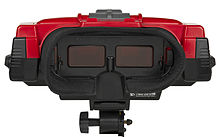Virtual boy
| Virtual boy | |||
|---|---|---|---|

|
|||

|
|||
| Manufacturer | Nintendo | ||
| Type | Handheld console | ||
| generation | 5th generation of consoles | ||
| publication |
|
||
| Main processor | 32-bit NEC V810 RISC (20 MHz) |
||
| Storage media | Modules | ||
| Controller | 6 buttons and 2 control crosses with 2 handles, one connection | ||
| Units sold | around 770,000 | ||
| Most successful game | Mario's tennis | ||
The Virtual Boy ( Japanese バ ー チ ャ ル ボ ー イ , Bācharu Bōi ) is a handheld console from Nintendo that was released in 1995 in Japan and the USA . The Virtual Boy is similar to a diving mask that you look into. Each eye perceives a different, slightly offset image, creating a real-looking 3D effect.
The console is a virtual reality headset , but unlike most VR headsets, it is not attached to the head, nor is it moved during use. Instead, the Virtual Boy has a stand so that it can be placed on a table while playing. The player controls with a supplied game controller .
Each of the two displays consists of red LEDs on a black background, which means that the image is monochrome. Nintendo did not use a colored picture because the green and blue LEDs available at the time were not efficient and the LCD technology was not suitable for the necessary frame rate of around 50 Hz due to its motion blur . In each of the two displays there are 224 red LEDs arranged in a row. Using a mirror that is swung back and forth by a mechanism at a high frequency, the image is generated with a resolution of 384 × 224 pixels. The mirror made the device smaller and more cost-effective than with a full LED assembly, but also more sensitive to impacts.
Technical details
| Weight | 760 g |
| size | 21.7 x 25.4 x 11 cm |
| Power supply | 6 × 1.5 V batteries |
| Playing time (with 6 batteries) | 7 hours |
| CPU | 32bit NEC V810 RISC |
| CPU clock | 20 MHz (18 MIPS) |
| Max. Resolution | 384 × 224 (per eye) |
| R.A.M. | 1 MB D-RAM |
| Video RAM | 512 KB P-SRAM |
| Cache memory | 1 KB |
| Sound | 16-bit stereo |
| Controller | 6 buttons and 2 control crosses with 2 handles |
| Frame rate | 50.273487773488 Hz |
Published games
- 3D Tetris (USA)
- Galactic Pinball (JPN, USA)
- Golf (JPN, USA)
- Insmouse No Yakata (JPN)
- Jack Bros. (JPN, USA)
- Mario Clash (JPN, USA)
- Mario's Tennis (JPN, USA)
- Nester's Funky Bowling (USA)
- Panic Bomber (JPN, USA)
- Red Alarm (JPN, USA)
- SD Gundam Dimension War (JPN)
- Space Invaders Virtual Collection (JPN)
- Space Squash (JPN)
- Teleroboxer (JPN, USA)
- V-Tetris (JPN)
- Vertical Force (JPN, USA)
- Virtual Bowling (JPN)
- Virtual Boy Wario Land (JPN, USA)
- Virtual Fishing (JPN)
- Virtual Lab (JPN)
- Virtual League Baseball (JPN, USA)
- Waterworld (USA)
reception
The Virtual Boy was a failure in Japan. Instead of the calculated 250,000 units sold, sales were 140,000 units. The release in the USA , in which Nintendo had further hopes, was also a failure. Critics cited several possible causes for the failure of the device:
- Prolonged gaming could cause a headache. The relevant warning on the packaging could have put off buyers.
- In addition, there were numerous discussions by parents who feared that the Virtual Boy would impair their children's eyesight.
- Many had expected a portable system and did not see their expectations of the device being met. Compared to common home consoles, many found the posture uncomfortable while gaming.
- The selection of software titles was limited, and only a few made meaningful use of the device's 3D capabilities. Game makers were reluctant to develop new games because the console's novel concept was untested.
- Due to the unfavorable release time, the Virtual Boy competed with the Sega Saturn , the PlayStation and also the widely announced Nintendo 64 , whose launch was imminent.
- Before the release, a two-player mode was announced, i.e. a way to connect two Virtual Boys together. However, this was never implemented.
Web links
- Planet Virtual Boy - largest Virtual Boy website on the net (also in German)
- neXGam.de - Reviews & Specials for the Virtual Boy
- Virtual Boy ( February 23, 2007 memento on the Internet Archive ) - Area on the Nintendo of America official website
- Virtual Boy area on the official website of Nintendo Co. Ltd. (Japan)
- AVGN (Angry Video Game Nerd) Virtual Boy Review - Review of all games published for the VB and the VB itself.
- The Unofficial Nintendo Virtual Boy Home Page - Dedicated to hacking the VB . Home of the Reality Boy VB emulator.
Individual evidence
- ↑ a b TASVideos / Platform Framerates. Retrieved March 4, 2020 .
- ↑ a b c d e Graham Flanagan: The incredible story of the 'Virtual Boy' - Nintendo's VR headset from 1995 that failed spectacularly. In: Business Insider. March 26, 2018, accessed April 4, 2019 .
- ↑ Marriott Guy, Ferry Groenendijk: Nintendo Virtual Boy. In: Video Game Console Library. Accessed April 4, 2019 .


